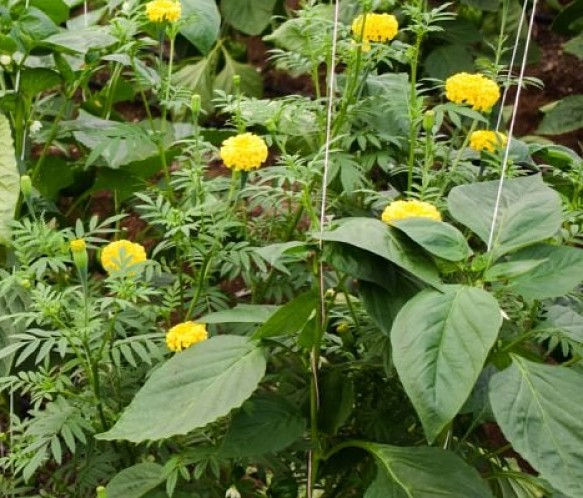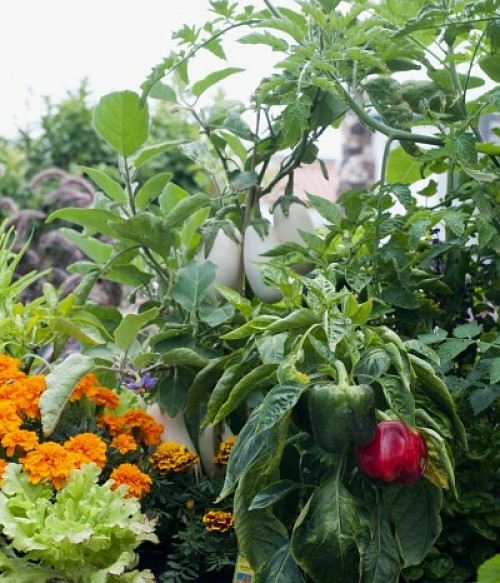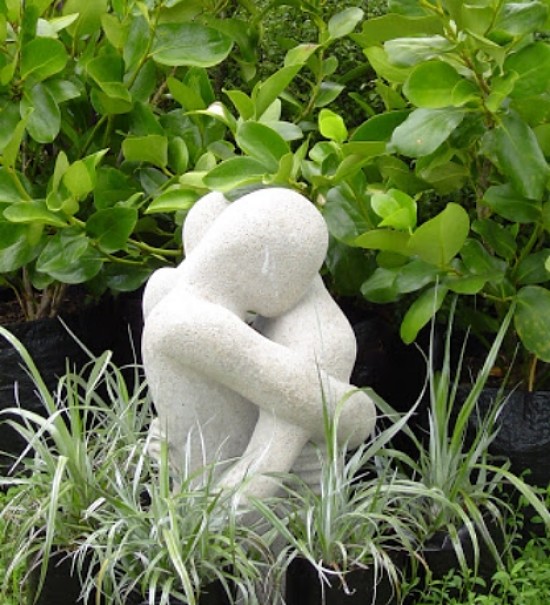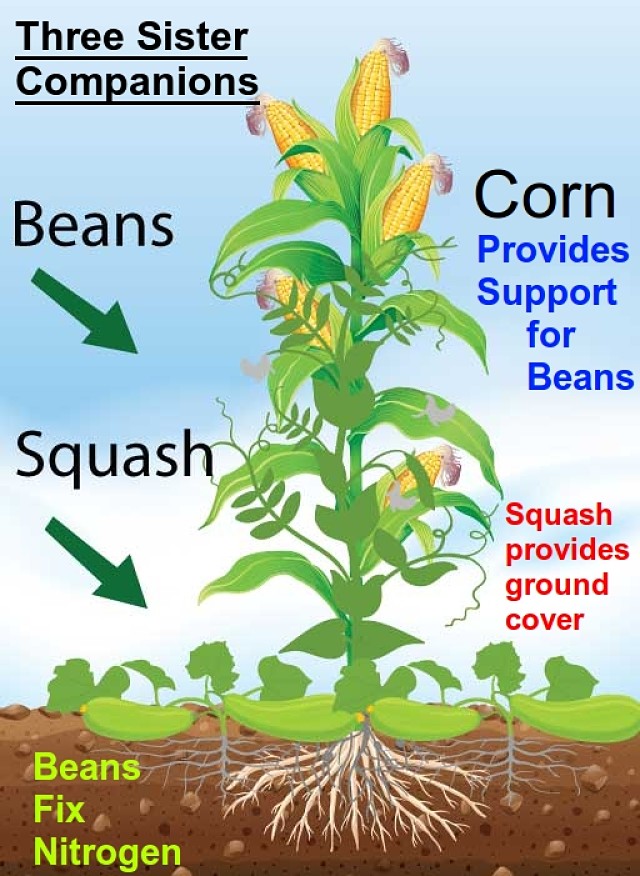Good and Bad Plant Bedfellows - Best Plant Companions and Foes for Vegetables
The first and fundamental reason for companion planting is to increase diversity. This is independent of any other reason such as pest control and nutrients. It makes sense that if all the plants in a patch are the one species, they will be competing for exactly the same nutrients and space, vertical and horizontal. Crowding the same species together increases the risk of spreading diseases, and pests will have a field day. If instead you plant different types of plants in a scattered pattern you will develop a balanced ecosystem with diversity.
This allows maximum beneficial interplay between plants. This extends to the creation micro-climates and genuine partnerships between plants that do well with each other. It can also confuse insect pests, and even birds by creating a diversity plant odours and a range of colours and shapes which will make pests less successful and easier to control. Likewise, diseases will be less likely to spread from plant to plant of the same species if they are spaced among other plants.

Pest and disease control are not the only advantages of companion planting. Some plants are nitrogen-fixers, storing nitrogen captured from the air made in their root systems. This extra nitrogen can become available for other crops. Likewise these plants will not be drawing upon the limited amount of nitrogen in the soil. So planting nitrogen fixing plants like beans and peas can be beneficial when paired with plants having high fertiliser demands.

Flowering plants in vegetable garden beds also help to attract pollinators. Other plants many provide a ground cover to simply suppress weeds, or provide partial shading.

Other benefit of companion plantings is to create vertical structure. One good example is planting corn with climbing beans or peas that can climb on the bean stalks. You can also plant squash, cucumber or pumpkin vines underneath. This principle of companion planting is called the "Three Sisters" and was used by Native Americans. Corn gives the beans or peas a structure to climb on. Beans lock atmospheric nitrogen in their roots helping to fertilise the soil and reducing demand for soil nitrogen needed by other plants. The spreading vines and leaves of pumpkins, cucumbers or squash create a living mulch and micro-climate that retains soil moisture and suppresses weed growth.

Some other Benefits of Companion Planting include:
Minimizing Risk for Yields - Companion planting increases odds of good yields from your garden patch. Even if one crop fails or is badly affected by natural hardships such as weather, pests or disease, the companion plants will still give you a yield.
Physical Plant Protection - Companion plants can offer a more delicate plant shelter from wind or shade from hot sun. Growing plants beside another more vigorous plant will shield and protect more delicate plants nearby.
Repelling Pests - Companion planting can be a good and effective organic pest management system. Plants that repel unwanted pests, or which lure pests away can protect more vulnerable plants.
Attracting Pollinators - Planting in close to others which produce a surplus of nectar and pollen can increase the population of beneficial insects in their vicinity, which will benefit other plants nearby.
Mutual Plant Health Benefits - Growing plants next to good bedfellow companions can improve the overall health of both plants.
Soil Structure Benefits - One plant’s root system can easily provide soil structure benefits for adjoining plants. For example, plants with long taproots like carrots and parsnips will break open the soil and draw on nutrients deep within the soil. This can benefit paired plants that have shallow root systems.
Row Cropping - Planting alternate rows of crops of various species can provide benefits for various plant pairs.
Water retention - Closely planting ground cover plants can reduce evaporation from the soil, benefiting taller plants companions.
Some other Benefits of Companion Planting include:
Nasturtiums have a unique scent that repels many insect pests
Alyssum attracts bees and other beneficial insects such as hover flies and lady beetles that control aphids
Basil has a strong scent that repels many insect pests.
Borage is a companion plant for tomatoes, squash and strawberries. Deters many pests.
Calendula flowers releases a sticky substance on their stems that attract and trap aphids
Caraway helps breakdown heavy soils and improves soil structure.
Catnip repels many insect pests, ants and rodents.
Chamomile attracts beneficial insects and pollinators and deters flies and mosquitoes
Chevril is a companion to radishes and leafy greens.
Chives and Garlic repel aphids
Chives are a good general purpose companion plant for most herbs and vegetables. makes a good garden buddy for rosemary is sage. However, rosemary is a fantastic complement to many vegetables.
Dill improves growth and health of cabbage.But do not plant near carrots.
Elderberry is a general insecticide
Fennel repels ants, flies and fleas.
French Marigold exudes a root secretion that helps to kill nematodes in the soil. It also repels white fly amongst tomatoes.
Garlic helps keep aphids away.
Horseradish is a good companion plant for potatoes.
Hyssop is a companion plant for cabbages and grapes, and also helps keep cabbage moths at bay.
Marigolds (Calendula) are a workhorse companion plant deterring insect pests and keeping the soil free of nematodes.
Mint repels cabbage white moth.
Nasturtium has a unique scent that repels many insect pests
Oregano is a good all-purpose plant for repelling most insect pests.
Parsley pairs well with tomatoes and asparagus.
Peppermint repels white cabbage moths
Petunia repels many insect pests.
Pyrethrum repels many insect pests.
Rosemary and Sage are good universal companion plant for carrots, cabbage, beans and sage. It also repels cabbage moths, bean beetles, and carrot flies.
Sage protects cabbages from cabbage white moth.
Summer Savory pairs well with beans, cabbage and onions. It repels white cabbage moths.
Tansy is another good, versatile companion plant for fruit trees, roses and raspberries. It deters a wide range of insect pests
Tarragon deters insect pests
Thyme deters cabbage worms.
Zinnias attract ladybugs into the garden and repel like cabbage flies.
Good Bedfellow Plants for Vegetables
| Plant | Good Bedfellow For |
| Anise | coriander |
| Basil | tomato, bell peppers |
| Bee balm | Tomato |
| Borage | squash, tomato, strawberry, bean |
| Chamomile | cabbage, most herbs, cucumber, melon, onion |
| Chervil | radish |
| Chives | grapes, tomato, carrot |
| Coriander | anise |
| Dandelion | many fruit trees |
| Dead nettle | potato |
| Dill | lettuce, onion, cabbage family |
| Dill, Immature | tomato, bell peppers |
| Garlic | beet, cabbage family |
| Horseradish | potato |
| Hyssop | grape, cabbage |
| Larkspur | cabbage family, beans |
| Lovage | beans |
| Marigold | potato, tomato |
| Mint | pea, tomato, cabbage family |
| Mustards | fruit trees, grape, beans |
| Nasturtium | radish, cucumber, |
| Onion | cabbage family, lettuce, strawberry, beet |
| Oregano | pumpkin, squash |
| Pigweed | corn, melon |
| Rosemary | beans |
| Rue | figs |
| Sage | tomato, carrot, strawberry, marjoram, cabbage family |
| Savories | bean, onion |
| Summer savory | melon |
| Sow thistle | melon,cataloupe |
| Tansy | most berries, blackberry, raspberry, strawberry |
| Tarragon | most vegetables |
| Thyme | potato, strawberry, eggplant, tomato |
| Yarrow | Most herbs |
Bad Bedfellows for Vegetables
| Plant | Bad Bedfellow For |
Anise |
Carrot |
| Beets | climbing bean |
| Cabbage | strawberry |
| Chives | peas, beans |
| Chrysanthemum | lettuce |
| Coriander | fennel |
| Dill | tomato, carrot |
| Fennel | bell pepper, beans |
| Garlic | peas, beans |
| Hyssop | radish |
| Kohlrabi | tomato |
| Larkspur | beet |
| Mustard | turnip |
| Onion | peas, beans, sage |
| Pole bean | beets |
| Potato | turnip, pumpkin, squash |
| Rue | basil, cabbage, sage |
| Sage | onion |
| Shallot | bean |
| Tansy | collard |
| Tomato | kohlrabi |
Companion Plants that Repel Insect Pests
| Pest | Repellent Plant as Companions |
| Ant | mint, tansy |
| Aphid | spearmint, peppermint, nasturtium, mustard, marigold, garlic, fennel, eucalyptus, coriander, clover, chives, including catnip and Most aromatic herbs |
| Asparagus beetle | tansy, tomato, basil, calendula, nasturtium, parsley, |
| Cabbage butterfly | tansy |
| Cabbage looper | thyme, spearmint, sage, rosemary, peppermint, pennyroyal, onion, nasturtium, hyssop, garlic, dill and catnip |
| Cabbage maggot | garlic, sage, tansy, thyme, marigold, radish |
| Carrot fly | tansy, sage, rosemary, onion, nasturtium, lettuce, leek and basil |
| Codling moth | garlic |
| Colorado potato beetle | catnip, nasturtium, onion, coriander, marigold, tansy |
| Corn earworm | cosmos, thyme, geranium, marigold |
| Cucumber beetle | tansy, rue, radish, nasturtium, marigold, corn and catnip |
| Cutworm | tansy, spiny amaranth |
| Flea beetle | tansy, spearmint, rue, peppermint, nasturtium, marigold and catnip |
| Flies | tansy, basil |
| Imported Cabbageworm | borage, thyme, tansy, sage, pennyroyal, onion, nasturtium, peppermint, geranium, garlic and dill |
| Japanese beetle | geranium, tansy, marigold, nasturtium, garlic, chives and catnip |
| Leafhopper | geranium, petunia |
| Mexican bean beetle | garlic, rosemary, marigold, nasturtium, savories |
| Mosquito | basil |
| Nematodes | calendula, French marigold |
| Peach borer | garlic |
| Pests in general | oregano |
| Slug and snail | rosemary, fennel, garlic |
| Spider mite | coriander, dill |
| Squash bug | tansy, spearmint, radish, petunia, peppermint, nasturtium, marigold and catnip |
| Squash vine borer | radish |
| Tomato Hornworm | dill, basil, borage, calendula, thyme |
| Whitefly | nasturtium, peppermint, thyme, basil |